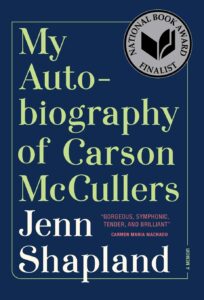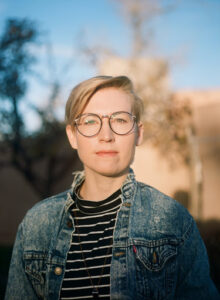by ROSE HIMBER HOWSE

Jenn Shapland, My Autobiography of Carson McCullers (Tin House, 2020), pp. 288.
This review was originally published in the Fall 2020 print issue of Carolina Quarterly.
In my application to graduate programs in fiction writing, I wrote that the Southern canon sang back to me certain notes of my experience, but condemned or ignored others. The lanky, tomboyish Mick Kelley, of The Heart is a Lonely Hunter, was my case study. Mick seemed so much like a queer character that her heterosexual encounters were difficult to make sense of–they felt to me, as a young queer reader, almost like a personal betrayal. In reading a preliminary review of Jenn Shapland’s debut, My Autobiography of Carson McCullers, out from Tin House Books, I was initially gobsmacked to learn that famed twentieth-century Southern author Carson McCullers was a lesbian. A few moments later, I realized I’d probably known it all along.
My Autobiography traces Shapland’s attempts to map this omission from McCullers’ cultural legacy and the accounts of her biographers, which parse nearly every other aspect of the author’s bohemian, liquor-laden personal life. The Heart is a Lonely Hunter was a precocious debut, released to great acclaim when McCullers was just 23. Like many of the other novels she penned before her death just three decades later, Hunter centers quirky outcasts from the margins of Southern society whose big emotional lives blossom in oxygen-deprived places. Her characters chafe against a multitude of constrictions, from the South’s most oppressive social forces to the limitations of language itself. McCullers’ work took the racism of small-town Georgia to task so unapologetically that she earned the public scorn of old guard greats like Flannery O’Connor. Ableism and homophobia are also frequent antagonists in McCullers’ oeuvre, but much of the latter is subtextual, particularly when the characters in question are girls or women. My Autobiography promises to be an uncovering of hidden facts but manages something more complex and more difficult—to write around absence until its outline begins to give it form.
As a disenchanted Ph.D. student, Shapland lands an archival internship at the University of Texas at Austin’s Harry Ransom Center, which becomes the setting for the memoir’s dual inciting incidents. It is amid the dank stacks that Shapland both meets Chelsea, her future partner, and discovers a trove of Carson McCullers’ love letters. Though the stylish Annemarie Clarac-Schwarzenbach, a transplant from Swiss high society to New York, was officially McCullers’ roommate during the author’s troubled marriage, the letters suggest more. For Shapland, who spent six years in a secret relationship with a “roommate,” this is the first of several uncanny coincidences that draws her to McCullers’ story. But are they so uncanny? Are they even coincidences? I, too, had a roommate who was more than a roommate before I came out. These shared experiences are also tropes of the closet, no less real for bordering, a bit exhaustingly, on the cliche.
Shapland begins her first public lesbian relationship alongside an obsessive deep dive into Carson McCullers’ romantic life. Though the women were born a half century apart, Shapland assures us that they share a sun sign if you use the right astrological calendar. Their lives converge not only in theme, but in two physical places. The first is the McCullers’ historic home in Columbus, Georgia, where Shapland stays for a residency; the second is Yaddo, the famed arts colony, where Shapland is admitted off the waitlist and feeds a mouse the afternoon carrot sticks she imagines McCullers didn’t eat, either. Like her subject, Shapland suffers from a chronic illness, possessing a particular empathy for the nefarious and ill-understood impact of ever-present fatigue on the life of a writer.
Rather than deny the inevitable projection of author onto subject, Shapland makes it into her memoir’s fundamental conceit, acknowledging the paradoxical similarities between the biographers who erased McCullers’ love of women to serve some image of their own making and her own desire to uncover that love for reasons that, while indisputably putting themselves in the way of truth, aren’t unselfish. We, as gay women writers, are always short on heroines. She’s upfront about her quest to make Carson into the lesbian mentor she doesn’t have in real life. “Here is where I come in,” she interjects in the middle of relating a story about one of Carson’s charged female friendships, “waving my rainbow flag.”
In the opening pages, Shapland explains that, “To tell her own story, a writer must make herself a character. To tell another person’s story, a writer must make that person some version of herself, must find a way to inhabit her.” She generally manages to pull off these kinds of lofty declarations, sweeping statements that might feel self-serious from another writer. They work here, I’d posit, because of how well they contrast with her self-effacing rendering of her former self as protagonist: a writer who struggles with imposter syndrome and whose foibles are never far from catching up with her. Her first night at an artist residency in Vermont, she drinks bourbon from a coffee cup, rationalizing that it’s what Carson would do, and spends the rest of the next day vomiting in the writing studios while others work on their books. It’s not a story many aspiring literary icons would rush to put in print.

In an explosive era for memoir, Shapland’s work is close on the heels of Carmen Maria Machado’s recent tour de force In The Dreamhouse. Published within three months of each other, taken together the two works seem to demonstrate convergent evolution: texts formed in response to the same literary landscape, one in which the queer canon is riddled with holes. “Other than my own,” Shapland writes, “I had never read love letters between women before.” The books also provide a similar visual experience: vignettes replace chapters, ample white space stands in for the silence pressing in on generations of closeted writers. Each contains a passage about historic erasure of relationships between women by way of gaps in language. Lack of terminology suppresses record keeping, turns what happened into what could have happened.
Perhaps, to me at least, the two books called to each other much like two queers nodding across a crowded train car. My Autobiography is, in style and in form, one of the most fundamentally queer texts I’ve read recently. In the vignette “They/Them,” Shapland tells of her interactions with the icon Eileen Myles, who spoke to her about “what it means to be queer in being and in writing.” Shapland doesn’t recall Myles’ exact definition, but summarizes that it was “something along the lines of constant shifting, the ever new.” That’s everywhere in these pages. Shapland is a self-professed lapsed scholar, and both parts of this identity emerge in her decidedly boundary-bending style choices. She can move seamlessly between an invocation of Proust or Barthes and the use of a word like “juicy” or “BFF.” One dutiful delineation of what she finds in the archives is punctuated by a winking parenthetical about Carson serving oysters at a party. In a couple instances, she also makes space for Carson’s own playfulness, telling us that she signed a love letter to her psychiatrist and probable lover Mary Mercer with the salutation “I kiss your little foot.” I wouldn’t have minded more of these anecdotes, which do more to humanize Carson than the recounting of tragedy alone.
Even as Shapland crisscrosses the country to dig into forgotten archives for traces of McCullers’ inner life, even as she goes so far as to describe Carson’s preserved socks, the way their stiff bumps still hold the shape of her toes, her thoroughness is selective—there’s plenty she excises that a traditional biographer never would. Sometimes, explanations for these omissions follow. “Biographers and their presumptions,” she explains, “have bothered me for a long time.” She compares what they do to “[breaking] into the house and rearrang[ing] the furniture to their liking.” Aware that her unique methodology creates its own gaps, she believes a sacred intimacy is created in exchange. “It is customary,” she acknowledges, “when writing a biography to talk to as many people who personally knew the subject as possible, but I instinctively avoided this…I wanted only the pieces in her words, and time.”
More than once, Shapland asks: Who am I to write this? But eventually, she’s bold enough to posit that perhaps she’s the only who could, that the stories of McCullers’ love for women are so “partial” that:
“To piece them together, you have to read like a queer person, like someone who knows what it’s like to be closeted, and who knows how to look for reflections of your own experience in even the most unlikely places.”
If the book could be said to coalesce around any one thematic question, perhaps it is what Shapland dubs “the burden of proof.” Was Carson a lesbian, and how do we know? The search for proof often involves “parsing…for subtext,” and there’s plenty to be found: an early letter between Carson and Annemarie contains the loaded and unadorned phrase “You remember.” Yet even while Shapland searches for proof, she asks why it’s necessary, why historical figures are assumed straight unless hard evidence suggests otherwise. In one vignette, she talks of an early picnic date with Chelsea during which they “fucked and talked for hours in the dark.” Whoa, I found myself thinking. Was that really necessary? It wasn’t until a few pages later that I realized—Jenn was lifting the burden of proof from us, the burden of parsing for subtext, and in doing so, refusing the possibility of erasure. I took a hard look at my initial reaction, at the part of me that found the sentence vulgar. Internalized shame can be minimized, but it’s never fully banished.
In coming into comfort with her own identity, Shapland stops making excuses for silencers. In the book’s opening, she states that “It doesn’t seem as if these are, for the most part, acts of censorship on the part of the biographers or the people they interviewed,” but by the final pages, she’s referring to the “flat-out lies” of the people who deny McCullers her honest legacy. (This includes, most notably, biographer Josyane Savigneau and the director of the McCullers Center in Columbus, Georgia). As infuriating as these revisionist histories might be, they’re no more brutal than the self-erasures Carson committed while she was alive. For me, the most devastating phrase in the book is what Carson and her husband called the women she loved: “imaginary friends.”
One of my favorite touches in the memoir is Shapland’s tendency to refer to McCullers as “Carson.” It’s incredibly tender, but also reveals a craving for ownership, which Shapland names, describing “the possessiveness I feel—I know her better.” In a book that’s fundamentally about intimacy, empathy and hunger feel like honest bedfellows. “Everyone wanted a piece of her,” Shapland admits, “Including me.”
To criticize a book that is so metaliterary, so earnestly engaged with its own shortcomings, can be redundant; fortunately, as perhaps is already apparent, I found little to criticize in this debut. Questions, sure. Carson’s suicide attempt is given startlingly little attention, and while it’s reasonable to attribute her suicidality at least in part to the impact of life in the closet, Shapland does little to parse other possible factors; the fact that McCullers’ father died by suicide is a parallel rich for examination, but receives none. Additionally, the analogy that Shapland is eager to draw between her own hometown, a “WASP paradise” suburb of Chicago, and Columbus, Georgia, is interesting as an indictment of the allegedly post-racial North, but also glosses over some of the South’s most insidious peculiarities.
But then, it’s her autobiography of Carson, after all. No one else’s. And it’s because of this–not in spite of it–that it becomes possible to find not only shards of Carson and shards of Jenn in this aching little book, but shards of ourselves, too.
Rose Himber Howse is a recent graduate of the MFA program in fiction at the University of North Carolina at Greensboro, where she served as fiction editor of The Greensboro Review. Her fiction and essays have appeared or are forthcoming in Hobart, Sonora Review, Joyland, YES! Magazine, and elsewhere.

